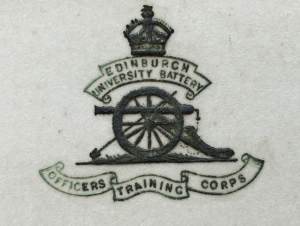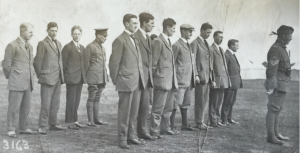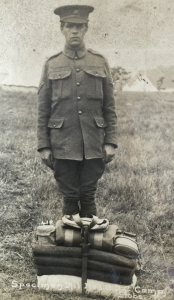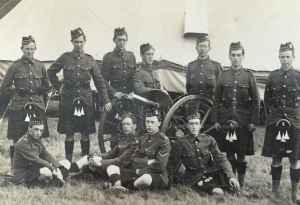LIFE IN THE ARMY, AT STOBS CAMP AND ELSEWHERE… AND SOME FACES OF THE FALLEN…
![]()
Edinburgh University Battery Officers’ Training Corps was one of Scotland’s oldest military volunteer Units. By 1860 undergraduates of the University had formed No.4 Company of the Queen’s Edinburgh Rifles and in 1872 they also supplied recruits to the 1st Edinburgh City Royal Garrison Artillery Volunteers. A Medical Volunteer Company was also formed in 1890. In 1908, they combined to form one of the original eight University Officers Training Corps (OTC) contingents.

Badge of Edinburgh University Battery, Officers’ Training Corps, on an invitation card inserted in ‘Minute Book. Artillery Unit. Officers ‘ Training Corps’, Dec. 1914 – Nov. 1920. EUA. Acc.99/017
Also in 1908, and as part of the Haldane Army Reforms, the OTC was formally established as a distinct unit in the British Army. It had the remit of supplying officers for the Special Reserve and the Territorial force. Against this background of Army reform, the Royal (Dick) Veterinary College OTC was also formed… in September 1912.

Officer recruits at a School of Instruction, Barry Camp, August 1914. Album in EUA. Acc.99/017.
On the outbreak of war in 1914, the OTCs would become officer-producing units, but as the war progressed high attrition rates meant that the demand for officers soon outstripped supply. Local Edinburgh recruits would pass through Stobs Camp, near Hawick, in the Scottish Borders, and attend the Officers’ School of Instruction at Barry Camp, near Carnoustie, in Angus.

A group of Sergeants at Stobs Camp, 1914. Album in EUA. Acc.99/017.
By the end of 1914, thousands of recruits were arriving at Stobs Camp to begin their transition from civilian to military life with up to 5,000 men being accommodated. Indeed, there were so many visitors to the Camp that an Exclusion Order was implemented to prevent civilians entering unless issued with a pass.

Specimen ‘kit’ displayed by a Sergeant at Stobs Camp, 1914. Album in EUA. Acc.99/017.
It had been intended that the Camp be used mainly as a summer training ground, and so the troops were only provided with tents. By 1917 however, the Camp contained at least 80 huts, a hospital with 150 beds, its own light railway, stores, workshops, Post Office, and a YMCA outside the perimeter. From October 1914, Stobs also served as a prisoner-of-war camp.

Photograph showing the Gun Team at Stobs, 1914, with Chilton, Balleny, Yorston, Robertson, Wedderburn, Calver, Laidlaw, Hill, Milne, Fraser and Waddy. Album in EUA. Acc.99/017.
The Gun Team of Edinburgh University Battery OTC was photographed in group at Stobs Camp in 1914. The Roll of Honour 1914-1919 of the University of Edinburgh notes that Medical student Frank Chilton, 1912-1914 (standing back left), from Christchurch, New Zealand, served in the OTC Infantry unit from October 1913 to August 1914. He became a Cadet in the 13th Argyll and Sutherland Highlanders, before becoming a 2nd Lieutenant in August 1914 and then Lieutenant in January 1915. He was then attached to the 2nd Hampshires, 29th Division, and was killed in action at Gallipoli on 4 June 1915 aged 23. He is honoured at the Helles Memorial (panel 183/184) which stands on the tip of the Gallipoli Peninsula in Turkey.

Photograph showing the Band at Stobs, 1914, with W.M.Hutchison, Mackay, W.M.McPhail, J.A.Robertson, N.McRury, C.G.N.Edwards, T.F.Murdoch, R. Hill, Duff, W.A.Sinclair, Younie, R.Coull, and J.D.Russell. Album in EUA. Acc.99/017.
Because of the lack of initials and the common surnames on the group photograph other Fallen from the Gun Team are difficult to identify. However, the general records of service of some war survivors from the group – with less common surnames – can be summarised. William Balleny (standing next to Chilton) for example, was an Arts student, 1913-1914, and like Chilton served in the OTC Infantry unit, though from October 1913 to September 1914. He became first a Cadet, then 2nd Lieutenant, then in September 1916 a Lieutenant with the 2nd Gordon Highlanders.
![]()
Robert MacDonald Yorston, a Science student from Montrose, 1912-1914, 1918, (and standing next to Balleny), served in the OTC Infantry unit from October 1912 to September 1914. He served as a Cadet with the 4th North Staffordshire Regiment, and then became a 2nd Lieutenant in August 1914, a Lieutenant and then a Captain in 1917. He served in France and was wounded at the Somme in July 1916. He was posted to Dublin from 1918 to 1919.
![]()
Edmond William Waddy (seated front right) had been a student at Merchiston Castle before becoming an Arts student, 1912-1915. He was a member of the OTC from 1908 and became involved with the University Battery OTC, Infantry unit, from October 1913 to October 1914. He was a Cadet with the Scottish Rifles, becoming a 2nd Lieutenant in October 1914, then a Lieutenant in November 1915, before assignment to the 56th Training Reserve Battalion in December 1916. He served in France in 1916 and 1917 an became an Acting Captain in July 1917. He was wounded during his war service.
![]()
At least two OTC men from the Band (photographed at Stobs) were killed in action. William Murray Hutchison from Sefton Park, Liverpool, had attended the Liverpool Institute, and been an OTC Cadet Colour-Sergeant there before studying at Edinburgh University. He had been part of the University Battery OTC, Infantry unit, October 1912 to August 1914. He was a Cadet then 2nd Lieutenant (August 1914) then Lieutenant (1915) then Captain (1916) with the Liverpool Regiment. He served in France in 1915 and was awarded the Military Cross as well as being Mentioned in Dispatches in May and September 1915. He died on 27 April 1916 after wounds received in France, aged 22. He lies in plot A.11 at Bruay Communal Cemetery Extension in the large village of Bruay, Pas-de-Calais, France.
![]()
Prior to studies at Edinburgh University and participation in the University Battery OTC, Infantry unit, from November 1909 to October 1914, Norman McRury (in front of Hutchison) had been a student at George Watson’s College. He was a Cadet Pipe-Major, then 2nd Lieutenant (October 1914) then Lieutenant (February 1915) with the 11th Royal Highlanders (Black Watch). He was attached to the King’s Own Scottish Borderers (KOSB) and was in Gallipoli in May 1915. Like Frank Chilton, McRury was killed in action at Gallipoli on 4 June 1915, aged 24. He too is honoured at the Helles Memorial (panel 144) which stands on the tip of the Gallipoli Peninsula in Turkey.
A second blog on the Edinburgh University Battery Officers’ Training Corps – OTC will appear before November 2018. The website of the Commonwealth War Graves Commission was also used in building this picture of University alumni associated with the OTC.
Edinburgh University Battery Officers’ Training Corps is now part of the City of Edinburgh Universities OTC.
Dr. Graeme D. Eddie, Assistant Librarian Archives & Manuscripts, Centre for Research Collections (CRC)
